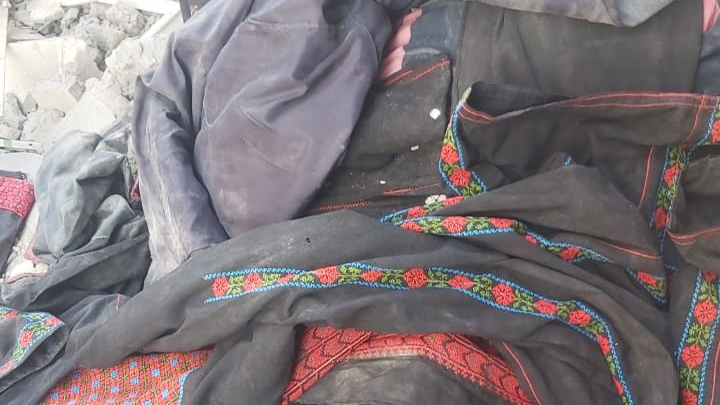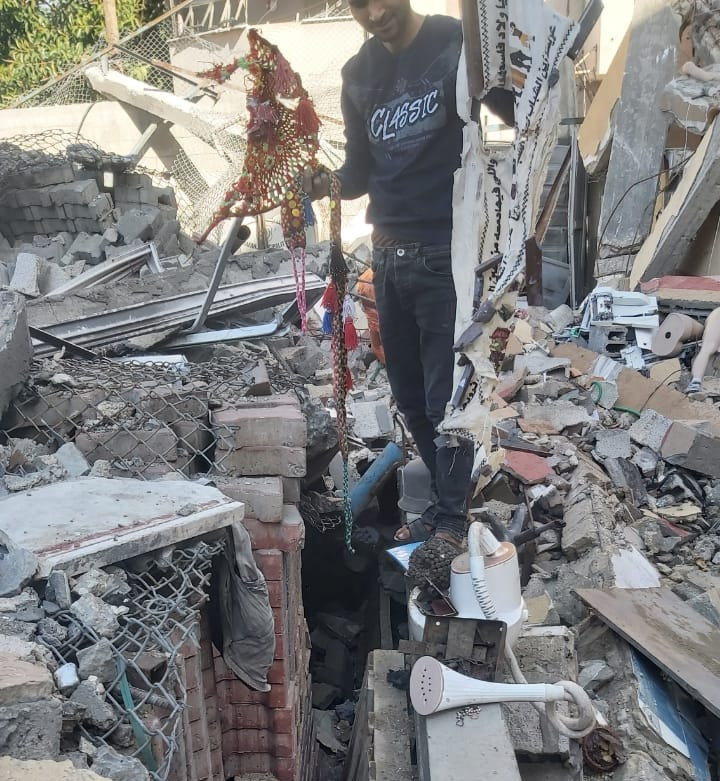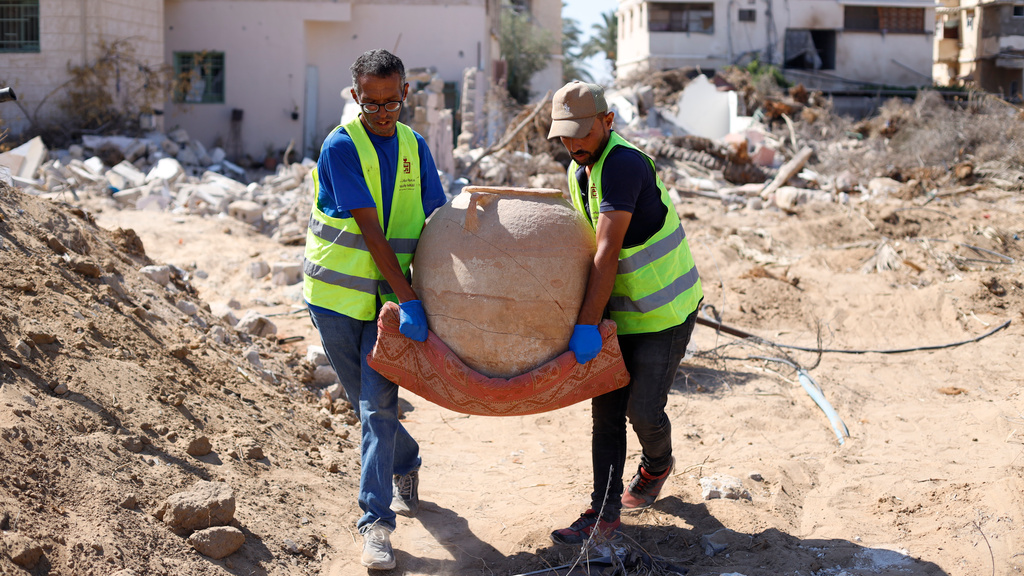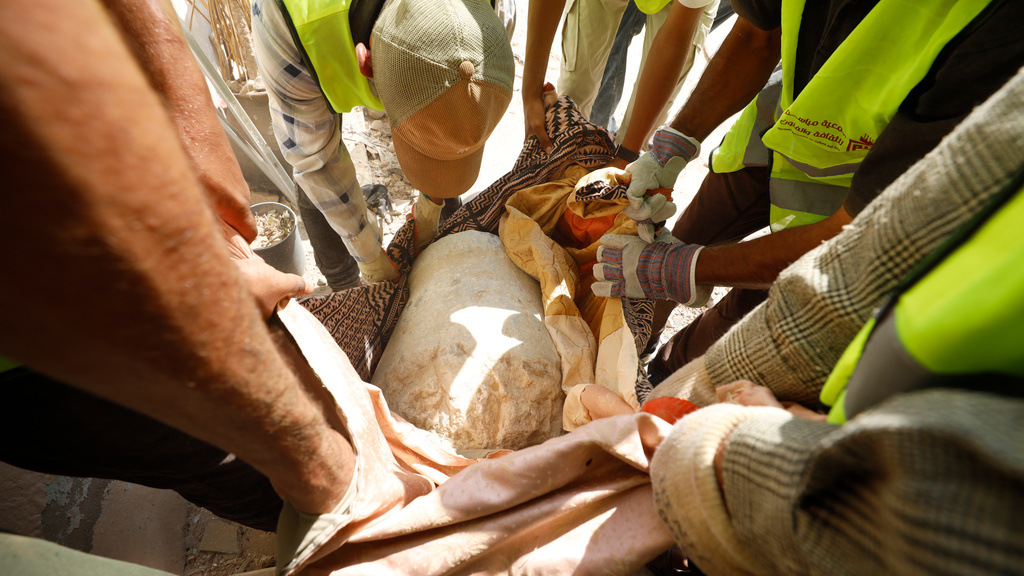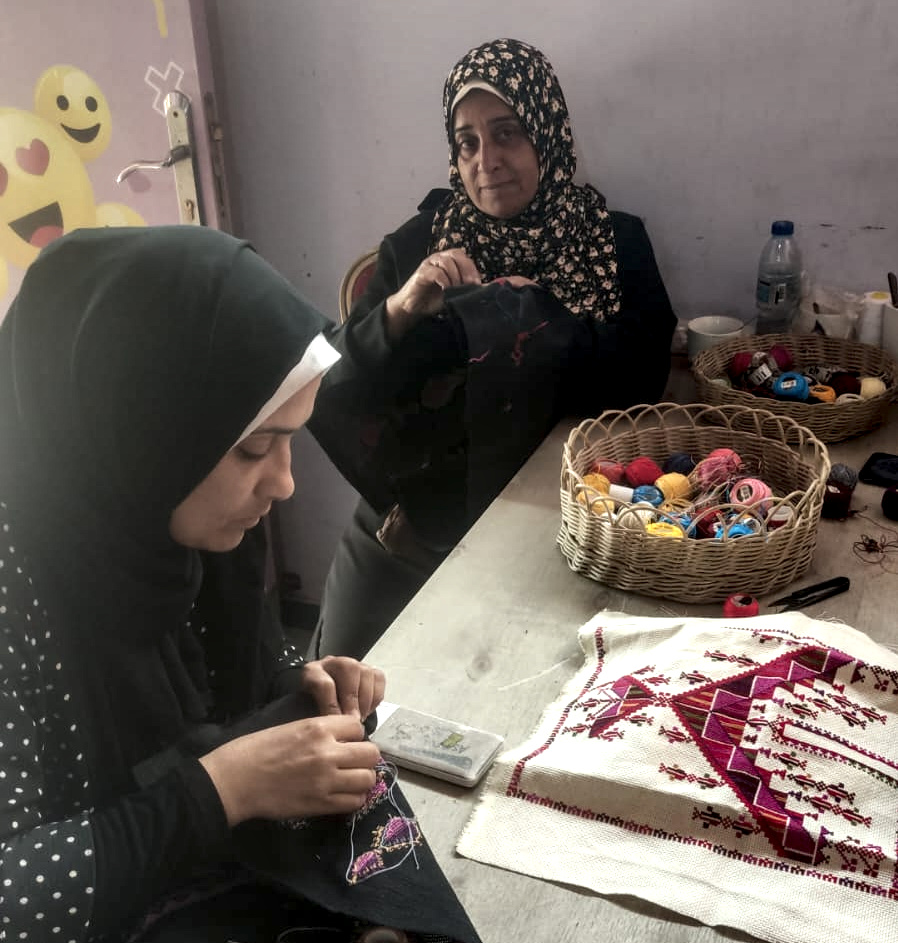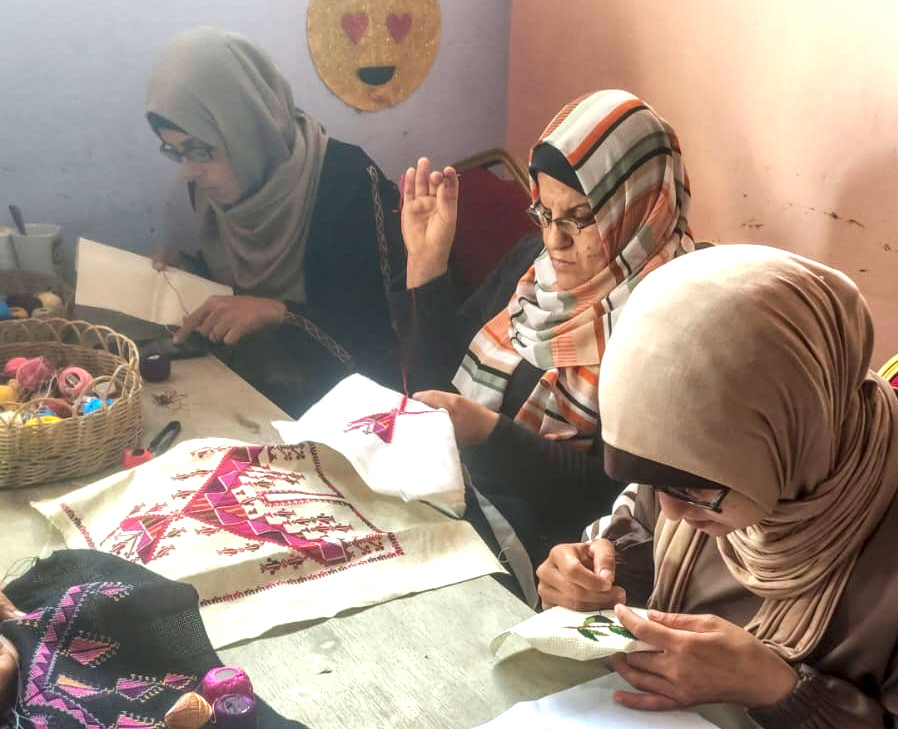While Amer Shomali describes the dramatic rescue of three dresses from Rafah, Sunbula reports on the current state of embroiderers in Gaza and Rachel Dedman reflects on a touring exhibition of tatreez from the Palestinian Museum.
The rescue from Rafah
Amer Shomali recounts the efforts of the Palestinian Museum to recover traditional dresses from the recently established Rafah Museum in Gaza, which was bombed on 28 October 2023.
On October 28th, the museum was bombed and totally destroyed. The collection was buried under the rubble. She contacted us at the Palestinian Museum. At that moment, we didn’t know exactly how you could. There are warplanes, jets, and rockets. We felt helpless, and there seemed to be nothing we could do from a distance. At some point, we partnered with Aliph, which provided us with a grant to evacuate the collections in Gaza. We managed to rent a bulldozer and we removed the rubble from the museum site. A team of maybe ten women got quick training online and on the ground in Gaza by Dr. Suhaila, the director of the Rafah Museum. They began digging under the rubble to retrieve the dresses from under the ground.
We retrieved almost 25% of the collection. The rest were either burned, looted, or totally damaged by the bombing. Some of the dresses, especially those on display at the moment of the explosion, were blown up into the sky. One landed on an electricity pole, and it took them a few months to get someone to climb up and get it down. The second dress was split into two pieces and blown in different directions. The first half was found a month later, but the second part, the sleeve itself, was found six months later, almost six kilometres from the museum. They managed to put the two pieces together. And the last one was a dress for a little girl, which was blown up into the sky and landed on top of a destroyed building nearby. But no one could manage to get up to the roof to get it until almost a year later.
We managed to get a crane to carry someone up to the top of the building to bring it down. We asked the collector if she could send us those dresses from Gaza. So, she began to visit the crossing point every day with a plastic bag containing the three dresses. She asked all the injured who are permitted to leave Gaza to be treated—in Egypt, Turkey, or somewhere around the world—to put the dresses among their luggage. But they all were afraid that if they got caught by the Israelis, it might compromise their leave and their treatment. So all of them refused to get the dresses out.
At some point, almost four months later, one of the artists in Gaza managed to convince a foreign doctor who was planning to leave Gaza after operating pro bono in the hospital in Gaza, to smuggle the three dresses among his luggage, leaving Gaza. So the doctor sent the dresses to the hospital like any injured Palestinian human being. In the hospital, the doctor came to see the dress and put it in his luggage.
Two days later, he left through Karm Abu Salam, the Israeli checkpoint. After checking his luggage, they didn’t see the dresses. He went to Jordan, and we sent someone from our side to Jordan to get the dresses back to Ramallah. When the dresses arrived, we took them out of the plastic bag and laid them on a big table. It looked like a morgue with a family of three bodies lying on the table. Then we put them into the deep freeze to kill all the insects. We also took a sample of the black dust on it, and we sent it to the laboratory. It came back tested as gunpowder. We plan to send those three dresses to be exhibited around the world as a witness to the genocide.
About Amer Shomali
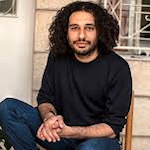 Amer Shomali (Arabic: عامر شوملي) is a Palestinian interdisciplinary visual artist who uses conceptual art, painting, digital media, films and comics to explore Palestinian sociopolitical issues and revolution iconography. He is currently the General Director of the Palestinian Museum. Follow @palmuseum
Amer Shomali (Arabic: عامر شوملي) is a Palestinian interdisciplinary visual artist who uses conceptual art, painting, digital media, films and comics to explore Palestinian sociopolitical issues and revolution iconography. He is currently the General Director of the Palestinian Museum. Follow @palmuseum
Embroiderers in Gaza today
The Palestinian craft organisation Sunbula reports on the current condition of embroiderers in Gaza.
- Embroiderers from Atfaluna Society, Gaza City, May 6, 2025.
- Atfaluna Society for Deaf Children (Courtesy of Sunbula)
Sunbula, a Jerusalem-based Palestinian fair trade organisation, has two partner craft producer groups in Gaza. Atfaluna Society, before this genocidal war, supported children and adults with hearing disability through education, audiology services, vocational training, and income generation through craft production that included embroidery, ceramics, woodcrafts, and weaving of traditional textiles. Sulafa Embroidery Centre, via a network of women’s centres, provided income-generation opportunities through traditional Palestinian embroidery and sewing work to women in the refugee camps. Both organisations were headquartered in Gaza City and provided services in all areas of the Strip.
The buildings of both organisations were destroyed in the Israeli airstrikes during the first months of the war, and they lost all their production space, equipment and materials. Their staff and artisans have been displaced multiple times. Sulafa Embroidery Centre reports that at least 20 of their artisans have been killed, including some of the best embroiderers. Atfaluna has also lost its staff members, including the craftwork supervisor.
During the January ceasefire, both organisations regrouped in Gaza City and are also operating in Deir Al-Balah, covering the north and the middle areas of the Strip. Throughout this war, the artisans from both groups have not stopped working, even during their displacements. Atfaluna currently has 60 artisans and Sulafa works with 471 women — they continue to produce beautiful work of embroidery and ceramics despite the challenges, not the least the lack of electricity for operating sewing machines or the limited availability of craft-making materials, the prices of which have more than doubled since the war began.
Crafts from Gaza were constantly the top sellers at Sunbula before the war — we are eager to restart selling them as soon as they become available, and to open the income stream that the artisans and their families so desperately need. Unfortunately, however, it is impossible to bring anything out of Gaza at the moment under the total prohibition by the Israeli military.
Sunbula is committed to continuing to support our Gaza partners by providing emergency aid in the meantime. Launched during the second week of the war, our crowdfunding campaign has raised over $100,000, which has been used to distribute aid parcels, set up learning spaces for students, provide psychosocial support for women and children, and provide direct cash assistance for women.
About Sunbula
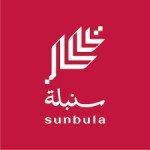 Sunbula is a Jerusalem-based nonprofit fair trade organisation dedicated to preserving Palestine’s artisanal heritage and empowering marginalised communities, particularly women, across the West Bank, Gaza Strip, and Palestinian communities within Israel. Visit sunbula.org and follow @sunbulapalestine.
Sunbula is a Jerusalem-based nonprofit fair trade organisation dedicated to preserving Palestine’s artisanal heritage and empowering marginalised communities, particularly women, across the West Bank, Gaza Strip, and Palestinian communities within Israel. Visit sunbula.org and follow @sunbulapalestine.
Tatreez exhibitions at the Palestinian Museum
Rachel Dedman reflects on the significance of Palestinian embroidery in the work of the Rumallah museum.
Why is tatreez important to Palestinians?
Tatreez is more than embellishment on clothing. It spoke to a woman’s character, to her identity, her personality, and her origins above all. The geographical specificity and regional variation of the craft in the late nineteenth century is what makes tatreez so remarkable compared to other global embroidery practices. All of this forges a heritage for tatreez that makes it particularly rich and meaningful in the present.
The other reason tatreez has evolved into a practice of such importance in the present is its politicisation after 1948. The Nakba displaced rural women from their land and their productive roles in agriculture, unseating tatreez’s embeddedness in rural life. Embroidery then becomes something that’s done in very different circumstances – in refugee camps in many cases – by women who are suddenly exiled from their homeland or living under occupation.
In the 1960s and 1970s, as the PLO deliberately set out to revive traditional heritage, tatreez was embraced as a force for asserting Palestinian identity and articulating Palestinians’ ancient connection to the land. Embroidery provided tangible evidence of centuries of Palestinian presence on their own soil. This process of reviving and politicising heritage transformed tatreez into an important national symbol, and the women who wore embroidery were central to this visualisation of Palestine.
The politicisation of tatreez reached its peak during the First Intifada, when the craft became more deeply associated with resistance and solidarity, worn on the front-line of protest. Intifada dresses involved a new vocabulary of motifs that spoke to contemporary Palestinian identity and resistance. Looking back at this long history of tatreez over the last century, it’s clear just how significant it is. It’s not simply a vital cultural tradition; it’s also a practice inextricably linked to the struggle for independence, freedom, and human rights. In 2021, tatreez was added to UNESCO’s Representative List of the Intangible Cultural Heritage of Humanity. I believe it’s this combination—being both a fascinating and rich historical craft and a powerful force for asserting identity, politics, and solidarity in the present—that makes it so crucial today.
What role do you see the Palestinian Museum playing in the culture of tatreez?
My journey with the Palestinian Museum began in 2013-2014, when I was working as an independent curator in Beirut and commissioned to develop an exhibition on tatreez. At that point, the museum was still being built, and they were already thinking of themselves as a transnational institution, which I found incredibly interesting. They were grappling with a profound question: what does it mean to be a Palestinian Museum when millions of Palestinians live outside Palestine, and there are such severe restrictions on movement, even within Palestine itself?
This question led them to develop fascinating international programs and collaborations. My early work on tatreez evolved into several exhibitions. First, there was At the Seams: A Political History of Palestinian Embroidery in Beirut, followed by Unravelled, which focused on global contemporary artists working with embroidery. Then Labour of Love: New Approaches to Palestinian Embroidery at the Palestinian Museum’s main site in Birzeit. In 2023, I curated Material Power: Palestinian Embroidery in the UK, and in 2025, Thread Memory: Embroidery from Palestine in Jeddah and V&A Dundee. This ongoing evolution of my research and curatorial practice on this subject has offered extraordinary opportunities to work with different collections and explore various ways to tell the stories tatreez holds.
The Palestinian Museum’s support has been instrumental in all this. What is particularly significant now is that the Museum has its own collection of tatreez. When I worked on At the Seams and Labour of Love, we borrowed from many other Palestinian collections in the region. But now, the museum in Birzeit is not only exhibiting this material globally but are also collecting it in trust for the nation, which is an important and powerful thing. As someone who works at a national museum in London, I see my work on acquisitions and collection-building as making a small contribution to the kinds of stories the institution can tell in the future.
So for me, it’s powerful that the Palestinian Museum is building this collection, and is creating shows all over the world that share these stories, seeking to humanise Palestine, demystify, educate, and inspire audiences who may never have been to Palestine or only know about it through the news. At this time of genocide, that feels more urgent than ever, and it’s certainly a responsibility I take very seriously in my own work. I feel deeply privileged to work for and with them. The opportunity to work on tatreez has come in great part because of my own privilege of mobility—I have passports that enabled me to travel between Palestine and Lebanon, which is not something citizens of either place can do. So that responsibility is very important to me, and I know the museum is working extremely hard at serving its community and audience, both at home and in the diaspora.
How do you feel about the increased use of machine embroidery in tatreez?
This is an interesting question. Our current age is defined by the industrialisation of clothing production and the proliferation of “fast fashion”, which has a profoundly negative impact on people and environmental resources, disproportionately located in the Global South. For those who don’t want to contribute to this economy, and for those who value the handmade, there’s been a resurgence of appreciation for marginalised or slower crafts. This may have been partly hastened by COVID-19, cost of living crises, and a greater appreciation for cultural traditions in a digital world.
When it comes to tatreez, there’s an urgency to preserve and ensure its longevity as a handmade craft. It might seem like machine-made embroidery is a threat to that, perhaps because it’s so much cheaper to produce and can undercut hand-embroidered tatreez, which is understandably expensive to buy. I see a nuance here, though. In its affordability, machine-made tatreez enables women in Palestine or in refugee camps in Lebanon or Jordan, who can’t necessarily afford handmade tatreez, to own a piece of tradition and express their identity on their body. Hand-stitched tatreez is very rarely worn on a day-to-day basis in Palestine anymore because of its price—women who embroider for NGOs rarely can afford to keep what they make—but you do relatively often see women, especially of the oldest generations, wearing and able to buy machine-made garments.
While we might prize the handmade above everything else today, back in the early twentieth century, machine-made work was actually considered desirable and luxurious in Palestine. The sewing machine became more available to Palestinian women in the late 1920s and 1930s, and that’s when you start seeing rural women gaining access to one. Machine-made details appear on traditional embroidered thobes (dresses) from this time onwards because these were signs that a woman had access to a sewing machine—she either owned one, could borrow one, or could commission this work. It was a mark of wealth, status, and high fashion. So, this idea of the handmade being most authentic and the machine-made being inauthentic is complicated by tatreez’s own history. Machine-made embroidery has been part of this heritage for at least 100 years.
My take on this is that the handmade will continue to preserve itself, and it’s incredibly important that it does. There are women professionally embroidering all over the region, and people worldwide have taken up the needle. Those inspired to learn tatreez are, in doing so, making the space between them and Palestinian women, particularly those suffering in Gaza, a little bit smaller. It’s an act of connection as much as of craft. The machine-made embroidery, on the other hand, is perhaps made accessible to people who don’t have the luxury of hand-stitched items. It’s arguably not as contradictory to the original craft as one might think.
About Rachel Dedman
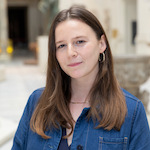 Since 2019, Rachel has been the Jameel Curator of Contemporary Art from the Middle East at the Victoria and Albert Museum. As a curator and writer, she is renowned for her decade-long exploration of Palestinian embroidery, or tatreez, and its significance as a cultural and political practice. As curator for the Palestinian Museum, she has led pivotal exhibitions including At the Seams in Beirut (2015), Labour of Love at the Palestinian Museum in Birzeit (2018), and Thread Memory: Embroidery from Palestine at Hayy Jameel in Jeddah (2025), each drawing deeply on the museum’s extensive digitised archives and family collections to foreground Palestinian voices and lived experiences. Visit racheldedman.com and follow @racheldedman. Portrait photo by Peter Kelleher.
Since 2019, Rachel has been the Jameel Curator of Contemporary Art from the Middle East at the Victoria and Albert Museum. As a curator and writer, she is renowned for her decade-long exploration of Palestinian embroidery, or tatreez, and its significance as a cultural and political practice. As curator for the Palestinian Museum, she has led pivotal exhibitions including At the Seams in Beirut (2015), Labour of Love at the Palestinian Museum in Birzeit (2018), and Thread Memory: Embroidery from Palestine at Hayy Jameel in Jeddah (2025), each drawing deeply on the museum’s extensive digitised archives and family collections to foreground Palestinian voices and lived experiences. Visit racheldedman.com and follow @racheldedman. Portrait photo by Peter Kelleher.



